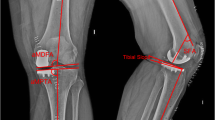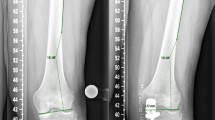Abstract
Purpose
The hypotheses were that firstly there is few early specific complications due to the use of a robotic-assisted system for unicompartimental knee arthroplasty (UKA), and secondly there are less revisions and complications after robotic-assisted UKA than after conventional UKA.
Methods
200 robotic-assisted UKA (175 patients) and 191 conventional UKA (179 patients) were performed between 2013 and 2018 from the same center. Revisions, intraoperative and postoperative complications, functional and radiological results were collected at the most recent follow-up.
Results
At the most recent follow-up (≥ 1 year), revision rates were 4% (n = 8/200) for robotic-assisted UKA and 11% (n = 21/191) for conventional UKA (p = 0.014). Reoperation rates without implant removal were comparable in the robotic and conventional group (7.3% vs 8.6%). Complication rates for stiffness (4.7% vs 4.2%) and infection (1% vs 1.6%) were comparable in both groups. There was no specific complication related to the robotic-assisted system (no soft tissue or bone lesion caused by the use of the robotic-assistance and no complication related to the use of navigation pins). The KSS function scores were higher following robotic-assisted UKA (p = 0.01). Satisfaction rates and contralateral OA were comparable in the two groups.
Conclusion
No complications due to the robotic-assisted system were found in this study. There was no difference in the general complications rate between both groups. Robotic-assisted UKA has a lower revision rate compared to conventional technique UKA at the short-term follow-up.
Level of evidence
III.
Clinical relevance
This is the first paper comparing revision rate and clinical outcome between UKA performed using the NAVIO robotic system and a conventional technique and searching for specific complication related to the use of the NAVIO robotic system.
Similar content being viewed by others
Abbreviations
- ACL:
-
Anterior cruciate ligament
- BMI:
-
Body mass index
- HKA angle:
-
Hip knee ankle angle
- KSS:
-
Knee Society Score
- TKA:
-
Total knee arthroplasty
- UKA:
-
Unicompartmental knee arthroplasty
References
Batailler C, White N, Ranaldi FM, Neyret P, Servien E, Lustig S (2019) Improved implant position and lower revision rate with robotic-assisted unicompartmental knee arthroplasty. Knee Surg Sports Traumatol Arthrosc 27:1232–1240
Battenberg AK, Netravali NA, Lonner JH (2020) A novel handheld robotic-assisted system for unicompartmental knee arthroplasty: surgical technique and early survivorship. J Robot Surg 14:55–60
Bell SW, Anthony I, Jones B, MacLean A, Rowe P, Blyth M (2016) Improved accuracy of component positioning with robotic-assisted unicompartmental knee arthroplasty: data from a prospective, randomized controlled study. J Bone Jt Surg Am 98:627–635
Blyth MJG, Anthony I, Rowe P, Banger MS, MacLean A, Jones B (2017) Robotic arm-assisted versus conventional unicompartmental knee arthroplasty: exploratory secondary analysis of a randomised controlled trial. Bone Jt Res 6:631–639
Canetti R, Batailler C, Bankhead C, Neyret P, Servien E, Lustig S (2018) Faster return to sport after robotic-assisted lateral unicompartmental knee arthroplasty: a comparative study. Arch Orthop Trauma Surg 138:1765–1771
Chalmers BP, Mehrotra KG, Sierra RJ, Pagnano MW, Taunton MJ, Abdel MP (2018) Reliable outcomes and survivorship of unicompartmental knee arthroplasty for isolated compartment osteonecrosis. Bone Jt J 100:450–454
Chun YS, Kim KI, Cho YJ, Kim YH, Yoo MC, Rhyu KH (2011) Causes and patterns of aborting a robot-assisted arthroplasty. J Arthroplasty 26:621–625
Citak M, Suero EM, Citak M, Dunbar NJ, Branch SH, Conditt MA et al (2013) Unicompartmental knee arthroplasty: is robotic technology more accurate than conventional technique? Knee 20:268–271
Cobb J, Henckel J, Gomes P, Harris S, Jakopec M, Rodriguez F et al (2006) Hands-on robotic unicompartmental knee replacement: a prospective, randomised controlled study of the acrobot system. J Bone Jt Surg Br 88:188–197
Debette C, Parratte S, Maucort-Boulch D, Blanc G, Pauly V, Lustig S et al (2014) French adaptation of the new knee society scoring system for total knee arthroplasty. Orthop Traumatol Surg Res 100:531–534
Dretakis K, Igoumenou VG (2019) Outcomes of robotic-arm-assisted medial unicompartmental knee arthroplasty: minimum 3-year follow-up. Eur J Orthop Surg Traumatol 29:1305–1311
Hamilton WG, Ammeen D, Engh CA Jr, Engh GA (2010) Learning curve with minimally invasive unicompartmental knee arthroplasty. J Arthroplasty 25:735–740
Hansen DC, Kusuma SK, Palmer RM, Harris KB (2014) Robotic guidance does not improve component position or short-term outcome in medial unicompartmental knee arthroplasty. J Arthroplasty 29:1784–1789
Herry Y, Batailler C, Lording T, Servien E, Neyret P, Lustig S (2017) Improved joint-line restitution in unicompartmental knee arthroplasty using a robotic-assisted surgical technique. Int Orthop 41:2265–2271
Jinnah AH, Augart MA, Lara DL, Jinnah RH, Poehling GG, Gwam CU et al (2018) Decreased time to return to work using robotic-assisted unicompartmental knee arthroplasty compared to conventional techniques. Surg Technol Int 32:279–283
Kamara E, Berliner ZP, Hepinstall MS, Cooper HJ (2017) Pin site complications associated with computer-assisted navigation in hip and knee arthroplasty. J Arthroplasty 32:2842–2846
Kayani B, Konan S, Huq SS, Tahmassebi J, Haddad FS (2019) Robotic-arm assisted total knee arthroplasty has a learning curve of seven cases for integration into the surgical workflow but no learning curve effect for accuracy of implant positioning. Knee Surg Sports Traumatol Arthrosc 27:1132–1141
Kayani B, Konan S, Pietrzak JRT, Huq SS, Tahmassebi J, Haddad FS (2018) The learning curve associated with robotic-arm assisted unicompartmental knee arthroplasty: a prospective cohort study. Bone Jt J 100-B:1033–1042
Kayani B, Konan S, Tahmassebi J, Rowan FE, Haddad FS (2019) An assessment of early functional rehabilitation and hospital discharge in conventional versus robotic-arm assisted unicompartmental knee arthroplasty: a prospective cohort study. Bone Jt J 101-B:24–33
Kleeblad LJ, Borus TA, Coon TM, Dounchis J, Nguyen JT, Pearle AD (2018) Midterm survivorship and patient satisfaction of robotic-arm-assisted medial unicompartmental knee arthroplasty: a multicenter study. J Arthroplasty 33:1719–1726
Lonner JH, Kerr GJ (2019) Low rate of iatrogenic complications during unicompartmental knee arthroplasty with two semiautonomous robotic systems. Knee 26:745–749
Lonner JH, Smith JR, Picard F, Hamlin B, Rowe PJ, Riches PE (2015) High degree of accuracy of a novel image-free handheld robot for unicondylar knee arthroplasty in a cadaveric study. Clin Orthop Relat Res 473:206–212
Mofidi A, Plate JF, Lu B, Conditt MA, Lang JE, Poehling GG et al (2014) Assessment of accuracy of robotically assisted unicompartmental arthroplasty. Knee Surg Sports Traumatol Arthrosc 22:1918–1925
Park SE, Lee CT (2007) Comparison of robotic-assisted and conventional manual implantation of a primary total knee arthroplasty. J Arthroplasty 22:1054–1059
Plate JF, Mofidi A, Mannava S, Smith BP, Lang JE, Poehling GG et al (2013) Achieving accurate ligament balancing using robotic-assisted unicompartmental knee arthroplasty. Adv Orthop 2013:837167
Sodhi N, Khlopas A, Piuzzi NS, Sultan AA, Marchand RC, Malkani AL et al (2018) The learning curve associated with robotic total knee arthroplasty. J Knee Surg 31:17–21
van der List JP, Chawla H, Joskowicz L, Pearle AD (2016) Current state of computer navigation and robotics in unicompartmental and total knee arthroplasty: a systematic review with meta-analysis. Knee Surg Sports Traumatol Arthrosc 24:3482–3495
Wysocki RW, Sheinkop MB, Virkus WW, Della Valle CJ (2008) Femoral fracture through a previous pin site after computer-assisted total knee arthroplasty. J Arthroplasty 23:462–465
Funding
This research did not receive any specific grant from funding agencies in the public, commercial, or not-for-profit sectors.
Author information
Authors and Affiliations
Contributions
GM: study design, data collection, statistical analysis, literature review and manuscript writing. CB, TL: study design, literature review and manuscript editing. ES: study design and manuscript editing. SL: study design, supervision, literature review and manuscript editing. All authors read and approved the final manuscript.
Corresponding author
Ethics declarations
Conflict of interest
GM and CB declare that they have no conflict of interest. L: Speakers bureau for Smith & Nephew and Arthrex, consultant for Amplitude. ES: consultant for Corin. SL: consultant for Stryker, institutional research support to Corin and Amplitude. No benefits in any form have been received or will be received from a commercial party related directly or indirectly to the subject of this article.
Ethical approval
All procedures were performed in accordance with the ethical standards of the institutional and/or national research committee, the 1964 Helsinki Declaration and its later amendments, or comparable ethical standards. The Advisory Committee on Research Information Processing in the Field of Health (CCTIRS) approved this study in Paris on February 17, 2016 under number 16-140. As per institutional standards, formal patient consent is not required for this type of study.
Additional information
Publisher's Note
Springer Nature remains neutral with regard to jurisdictional claims in published maps and institutional affiliations.
Rights and permissions
About this article
Cite this article
Mergenthaler, G., Batailler, C., Lording, T. et al. Is robotic-assisted unicompartmental knee arthroplasty a safe procedure? A case control study. Knee Surg Sports Traumatol Arthrosc 29, 931–938 (2021). https://doi.org/10.1007/s00167-020-06051-z
Received:
Accepted:
Published:
Issue Date:
DOI: https://doi.org/10.1007/s00167-020-06051-z




